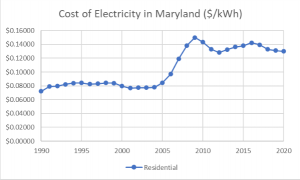Residential Electricity Costs in Maryland
The residential cost of electricity in Maryland and how it may affect the cost savings for a solar installation has become a common question raised.
Let’s take a look at the average cost of electricity in Maryland during the period 1990 to 2020 (a period of 30 years). As you can see, the cost of electricity was fairly flat from 1990 to 2005, and then jumped (associated with the restructuring of the electricity sector) to another essentially flat period from 2011 to 2020. Given the features of the graph, the long-term trend is up (increasing prices), but the trend line is not steady. An average year-over-year escalation rate for the period 1990 to 2020 would be approximately 2%/year.
Figure 4: Maryland Residential Electricity Price ($/kWh)
Source: Electricity Rate: US Energy Information Administration (eia.gov/electricity/state/Maryland/ Data Table 8).
Cost of electricity in 1990 =7.223 cents/kWh. Cost of electricity in 2020 = 13.005 cents/kWh
Equation: Final cost of electricity = Initial cost of electricity * (1 + Escalation rate)Number of years
Solving this equation results in:
Calculation: Escalation rate = ((.13005/.07223)^(1/30))-1 = 0.0198 or ~2%
Savings from the installation of a solar system are normally estimated by comparing the cost of your electricity bill (without solar) – over a given period – to the total cost of electricity, including energy from both the solar system and the utility during the same period. Raising the average year-over-year electricity cost escalation rate will increase the apparent cost of electricity (without solar), which increases the forecast savings from installing the solar system. It is important to use a reasonable (justifiable) escalation rate to achieve an accurate estimate of overall cost savings.
Solar systems operate over a 20 to 30 year timeframe, so looking at long term costs is likely a more effective savings estimate than using short term increases in the cost of electricity. However, the energy markets have changed dramatically since 1990. We now live in a more global economy. The fuel mix for the electric grid has changed, with natural gas replacing coal as the largest component of fuel for electric generation. Natural gas prices remained low as production increased in the United States, but that may not remain the case in the future. New fuel technologies may raise or lower the retail cost of electricity to the consumer. The bottom line is past performance is no guarantee of future electricity costs. When shopping for a solar energy system, the solar sales representative should disclose and be able to justify the energy escalation rate that they use in their calculations and provide the customer with a realistic estimate of cost savings for the proposed solar installation.


 1-888-373-7888
1-888-373-7888 233733
233733